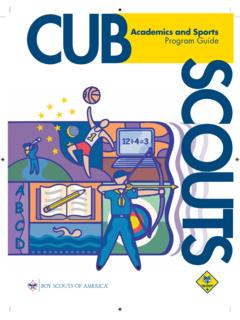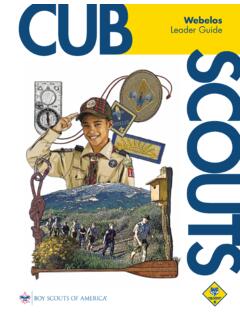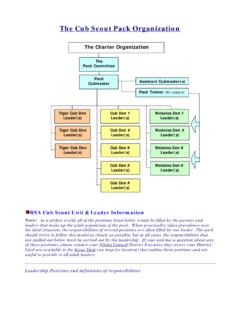Transcription of CEREMONIES for Dens and Packs
1 CEREMONIES for Dens and PacksTHANKS TO YOU, MILLIONS OF BECOME MORE GROW ARE BETTER LEARN LIFE HAVE FUN!WITHOUT YOU, THEY WOULD Boy Scouts of America welcomes your comments and suggestions on how to improve this resource. Please e-mail your thoughts to FOR DENS AND PACKS33212 ISBN 978-0-8395-3212-5 1999 Boy Scouts of America2010 PrintingiiiChapter 1. Introduction to CEREMONIES ..1-1 1-3 Chapter 2. Den CEREMONIES ..2-1 2-7 Chapter 3. Staging pack Meeting 3-7 Chapter 4. Flag CEREMONIES ..4-1 4-7 Chapter 5. pack Meeting Opening CEREMONIES ..5-1 5-12 Chapter 6. pack Meeting Closing CEREMONIES ..6-1 6-8 Chapter 7. Induction CEREMONIES ..7-1 7-3 Chapter 8. Advancement CEREMONIES ..8-1 8-14 Chapter 9. Transition CEREMONIES ..9-1 9-5 Chapter 10. Other Opportunities for CEREMONIES ..10-1 10-5 Chapter 11. Outdoor and Campfire CEREMONIES ..11-1 11-3 Chapter 12. Den Chief and Adult CEREMONIES ..12-1 12-5 Appendix ..A-1 I-6 Cub Scout CEREMONIES for Dens and PacksCONTENTSC ontents1-1 Why Do We Use CEREMONIES ?
2 1-2 What Kinds of CEREMONIES Are Used at Den Meetings? 1-2 What Kinds of CEREMONIES Are Used at pack Meetings? 1-2 Tips for Effective CEREMONIES , 1-2 Tips for Using This Book, 1-3 Limitations? 1-3 CEREMONIES Encourage Advancement, 1-3 What Is Advancement? 1-3 Cub Scout Advancement Goals, 1-3 CHAPTER 1 Introduction to CeremoniesIntroduction to Ceremonies1-2 Why Do We Use CEREMONIES ? CEREMONIES play an important part in our lives. We have CEREMONIES to celebrate birthdays, holidays, graduations, weddings, religious events, and many other special occasions. CEREMONIES are also an important part of Cub do we have CEREMONIES in Cub Scouting? Everyone likes to receive recognition. A den or pack ceremony helps to recognize a boy in a positive way. CEREMONIES provide meaningful and memorable highlights in a boy s Cub Scouting experience. CEREMONIES help teach the ideals and goals of Scouting. As boys participate in CEREMONIES , they learn by doing.
3 CEREMONIES focus attention not only on boys but also on families, leaders, and volunteers. All involved earn recognition for their should be a regular part of den and pack meetings. CEREMONIES define the beginning and the end of meetings, and they provide a format for presenting awards. Using CEREMONIES stimulates and encourages increased participation in monthly pack you remember the best ceremony you ever saw? The worst? What was the difference between the two expe-riences? When you can answer these questions, you ll be ready to put what you know into practice and make a difference in the experience a boy will have when he receives his Tiger Cub badge or crosses a bridge into Boy Scouts. Cub Scouts will remember their awards and how they were recognized for earning them, and fami-lies will value these occasions as memorable highlights on the Scouting Kinds of CEREMONIES Are Used at Den Meetings? An opening ceremony signals the beginning of the den meeting.
4 The presentation of immediate recognition in fun and easy CEREMONIES acknowledges the progression toward rank advancement. Denner installation recognizes boy leaders and the importance of this position in the Cub Scout and Webelos den. Special recognition CEREMONIES mark special achievements reached both in and out of Scouting. A closing ceremony brings a quiet, inspirational end to the den Kinds of CEREMONIES Are Used at pack Meetings? Opening CEREMONIES set the stage for the pack meeting and can reflect the Core Values. Flag CEREMONIES teach boys how to handle and present the flag in a respectful way. Induction CEREMONIES welcome new boys and their families into the pack . Advancement CEREMONIES celebrate the completion of requirements for Bobcat, Tiger Cub, Wolf, Bear, and Webelos ranks, and for the Arrow of Light Award. Transition CEREMONIES mark the transitions for Cub Scouts from Tiger Cub to Wolf, Wolf to Bear, Bear to Webelos Scout, and Webelos Scout to Boy Scout.
5 They encourage boys to make the step up to their next challenge on the Scouting trail. Closing CEREMONIES bring the meeting to a close and send everyone home with inspirational ideas to think about. It is also important to remember CEREMONIES for den chiefs and adults. These CEREMONIES include den chief inductions, Den Chief Service Awards, den chief recog-nition, leader inductions, leader and family thank-yous, recognition of leader training, and Cub Scout leader recognition plan awards. These CEREMONIES let your leaders know that you appreciate the commitment they are making and their efforts toward bringing a quality program to the are many other opportunities for CEREMONIES . Take the time to focus on the presentation of Gold Arrow Points, Silver Arrow Points, Webelos activity badges, Academics and Sports belt loops and pins, the World Conservation Award, National Summertime pack Award, Fun for the Family Award, National Den Award, Cub Scout Outdoor Activity Award, Good Turn for America, Emergency Preparedness Award, and recognition of tenure and service projects.
6 There are also presentations of Centennial Quality Unit Awards, pack charters, and special anniversary for Effective CeremoniesWhen planning your CEREMONIES , remember these important points: Know your audience. Keep your CEREMONIES appropriate for boys of Cub Scout age. Simple cer-emonies are more effective than long, elaborate ones. Boys this age have a short attention span. Rotate responsibility among the dens for the opening, flag, and closing CEREMONIES at the pack meeting. When boys are involved, it is easier to hold their attention during the pack to Ceremonies1-3 Use a variety of CEREMONIES to hold the boys and adults interest. Keep track of which CEREMONIES you use and avoid repeating them month after month. Adapt CEREMONIES to meet your needs. Packs come in many different sizes, and boys come with different skill levels. Younger boys may need to have someone read their lines while they perform an action or hold a sign.
7 No ceremony is written in stone. Volunteers have writ-ten or adapted those presented here to meet the needs of their Packs . Feel free to change them to work for you! This makes them your CEREMONIES . Then try using the All-Purpose, All-Occasion Ceremony Creator in Chapter 10 to get started writing your own for Using This BookUse this book as a launching point for your CEREMONIES . Photocopy it, scan it, rewrite it! Highlight each person s part and tape it on the back of the prop that person may hold or use. Make sure that the print is large enough to be easily read, even in low-light of us are better at some things than others. Some boys and adults in your pack may have additional chal-lenges because of disabilities. When you plan ceremo-nies, check with adults, leaders, and boys to make sure they are comfortable with their parts. They will help you ensure that the CEREMONIES you use are both appropri-ate and fun for all to do.
8 Everyone can play a part when you plan Encourage AdvancementRecognition is important to boys. When they are recog-nized for their accomplishments, they are motivated to achieve more. The advancement plan provides fun for the boys, gives them a sense of personal achievement as they earn badges, and strengthens family understanding as adult family members work with boys on advance-ment Is Advancement?Advancement is one of the methods used to achieve the aims of Scouting in all phases of the Scouting program (Cub Scouting, Boy Scouting, and Venturing). The aims of Scouting are character development, citizenship training, and personal is the process by which a Cub Scout meets certain requirements and receives recognition. He progresses from badge to badge, learning new skills as he goes. Advancement is simply a method or a means to an end, not an end in itself. Everything that is done to advance and earn these ranks, from joining until leav-ing the Scouting program, should be designed to help the boy have an exciting and meaningful experience in information about advancement and recognition can be found in the Cub Scout Leader Scout Advancement GoalsThe administration of the Cub Scout advancement pro-gram is primarily the responsibility of the pack commit-tee, with the support of the district advancement com-mittee and the commissioner staff.
9 They work together to see that the following standards are met. The pack should maintain detailed advancement records to ensure that boys are advancing and that awards are presented promptly to each boy. Families of Cub Scouts should understand their roles and responsibilities in their boys advancement. For the boy to receive maximum benefit and growth from his achievement, the standard for completion of any requirement should be based on the Cub Scout motto, Do Your Best. Den chiefs (Boy Scouts, Varsity Scouts, or Venturers who help with Cub Scout and Webelos Scout den meetings) can help stimulate advancement through example, as well as encourage boys to continue in the Scouting program. Presentation of badges or other recognition items should be a part of each monthly pack meeting. Badges and other recognitions should be presented as soon as possible after a boy completes the require-ments. He should be recognized during a ceremony at the monthly pack meeting.
10 Packs and troops should be encouraged to work together to ensure a smooth transition from the Webelos den to the Boy Scout troop. Suggestions for advancement CEREMONIES may be found in the Den & pack Meeting Resource Guide, the Webelos Leader Guide, the Cub Scout Leader Book, at monthly Cub Scout roundtables, and in this to Ceremonies2-1 Why Do We Have Den CEREMONIES ? 2-2 CeremoniesHandshake Opening, 2-2 Tiger Cub Roll Call Opening, 2-2 Cub Scout Promise Opening, 2-2 Tiger Cub Opening Ceremony, 2-2 Orange Bead Recognition, 2-2 White Bead Recognition, 2-3 Black Bead Recognition, 2-3 Tiger Cub Closing, 2-3 Tiger Cub Closing Song, 2-3 Cub Scout/Webelos Scout Light, 2-3 Opening/Closing Song Ceremony, 2-3 Pledge of Allegiance Opening, 2-3 Roll Call Opening, 2-3 Den Flag Opening, 2-3 Law of the pack /Scout Law Opening, 2-3 Cub Scout Promise/Scout Oath Opening, 2-3 CHAPTER 2 Den CeremoniesDen Ceremonies2-2 Cub Scout/Scout Motto Opening, 2-3 Den Yell Opening, 2-3 Cub Scout Shirt Bobcat Recognition, 2-3 Snowflake Immediate Recognition, 2-4 Den Doodle for Advancement, 2-4 Immediate Recognition Balloons, 2-4 Immediate Recognition Fishing, 2-4 Denner and Assistant Denner Installation, 2-4 Denner and Cub Scout Stamp Installation, 2-4 Brotherhood Circle Closing, 2-4 Handshake Closing.



